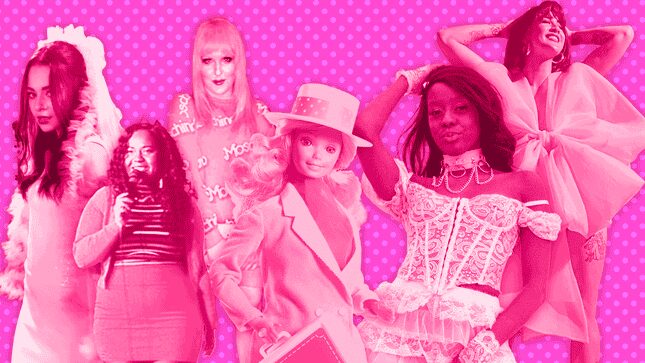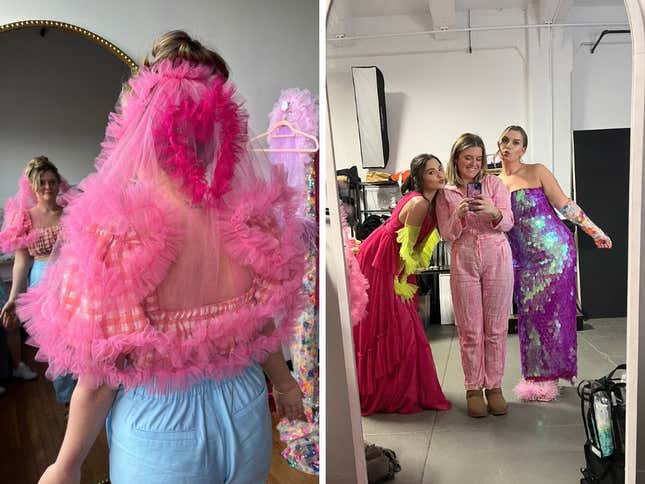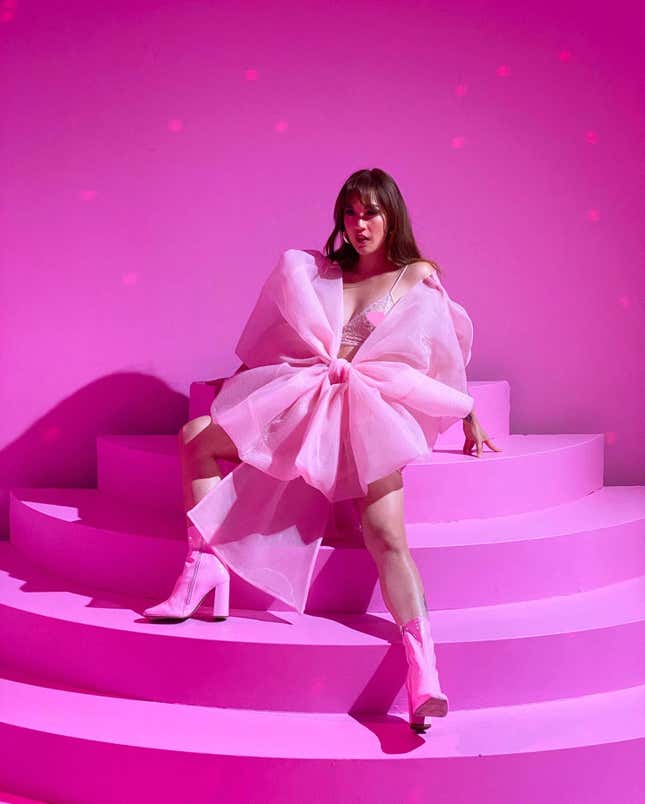The Barbie Pink Rebellion Is Underway
Girly but subversive, mocking and a little bit bloody, the polarizing color means a lot more to people than Barbie herself.
In DepthIn Depth
Graphic: Vicky Leta
Darian Darling is living her dream life in her dream house—that is, her very own life-size Barbie Dreamhouse. The all-pink home, as featured in Apartment Therapy in 2010, went quasi-viral, she remembers. In photos, you can see how stubborn it is in its girlhood, with figurines of Betty Boop and Marilyn Monroe, pink-stained pillows, and in the corner, Darling’s life-size Barbie mannequin. Unlike the original, this Barbie’s swimsuit is pink.
Darling, a makeup artist, is somewhat of a pink evangelist. She loves the sweeping rosy texture of blush, a product she insists never goes out of fashion as she applies it liberally to the cheeks of her clients. Darling bonded with one such client, drag queen Trixie Mattel, over their shared love of pink and all things Barbie, which they both still collect as adults (“I’m sure a therapist would have a field day with what exactly that means,” Darling laughs). At the Barbie premiere this month, Trixie showed up most of the cast’s pink carpet looks, surely in part because she, like Darling, didn’t need Greta Gerwig’s campy film to discover pink’s subversive side.
“In the ‘80s, going to the Toys ‘R’ Us Barbie aisle that was floor-to-ceiling hot pink…it gave me tingles,” Darling told Jezebel. “Barbie had this heightened idea of femininity and beauty…this unapologetic, almost unattainable, aspirational glamour, which as a kid I just loved, but especially as a trans child.”

For Darling, drag’s exaggerated use of personas, makeup, and color mirrors Barbie’s cartoon-ish attempts at womanhood. That hot pink unites them is kismet, though it isn’t the sole reason she’s decked her life in pink. “I do love the camp and humor of it,” she said. “And I love that it pushes people’s buttons…that it is polarizing and aggressive.”
Regardless of the name it takes on—shocking pink, Schiaparelli pink, bimbo pink, or Barbie pink—this hot pink hue has worked its way into some of our most visible cultural venues. It veils the nipples of It Girls, struts down Valentino runways, and appears in TikTok holes of aesthetics past. For some, it is a loaded shade that may forever stir up less-than-sweet memories of an impossible girlhood sold in a fuschia cardboard box. But others, like Darling, turned to it for comfort long before the Barbie movie began advertising a life lived boldly in pink.

Pink is an exercise in contradictions, delicate and violent in the same breath. Though its origins are murky, some sources point to the 17th century use of the term “pinks” to describe flowers with jagged petals—carnations, sweet williams, and maiden pinks among them. But “to pink” had another meaning: to stab.
In 1931, fashion designer Elsa Schiaparelli captured those contradictions when she invented a new pigment by mixing magenta with a bit of white. “The color flashed in front of my eyes,” Schiaparelli said. “Bright, impossible, impudent, becoming, life-giving, like all the lights and the birds and the fish in the world put together.” Later, Darling points out, Yves Saint Laurent described the same color as “having the nerve of red…an aggressive, brawling warrior pink.”
Today’s hot pink has retained its biting spirit, which is, in part, why it’s a key tenet of fashion designer Madison Chamberlain’s brand identity. Her core customer base, which she describes as “nontraditional brides,” comes to her for her over-the-top pink gowns and pink, ostrich feather veils, as if to throw daggers at the rest of the bridal industrial complex.
-

-

-

-

-

-

-

-

-

-

-

-

-

-

-

-

-

-

-

-

-

-

-

-

-

-

-

-

-

-

-

-

-

-

-

-

-

-

-

-












































